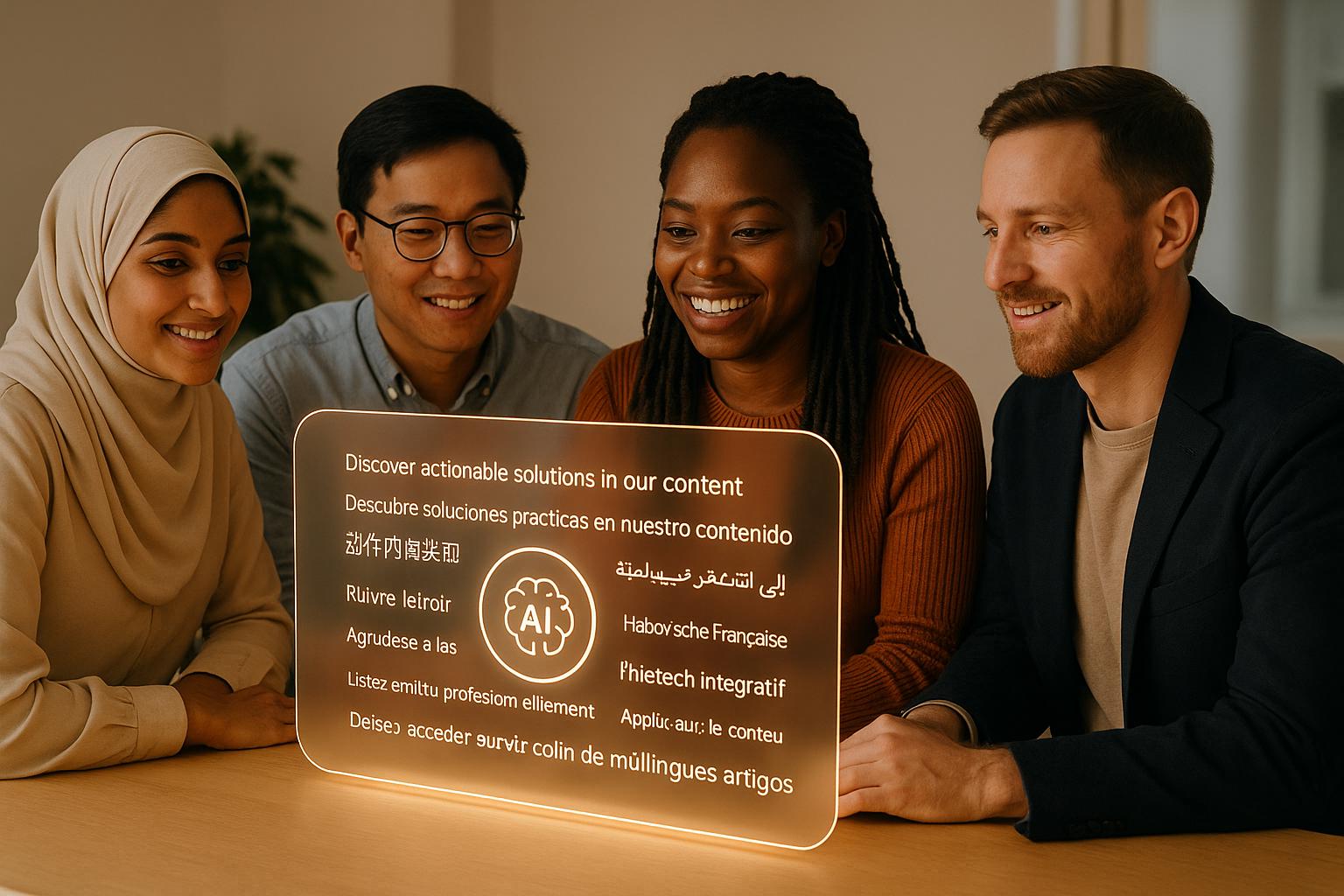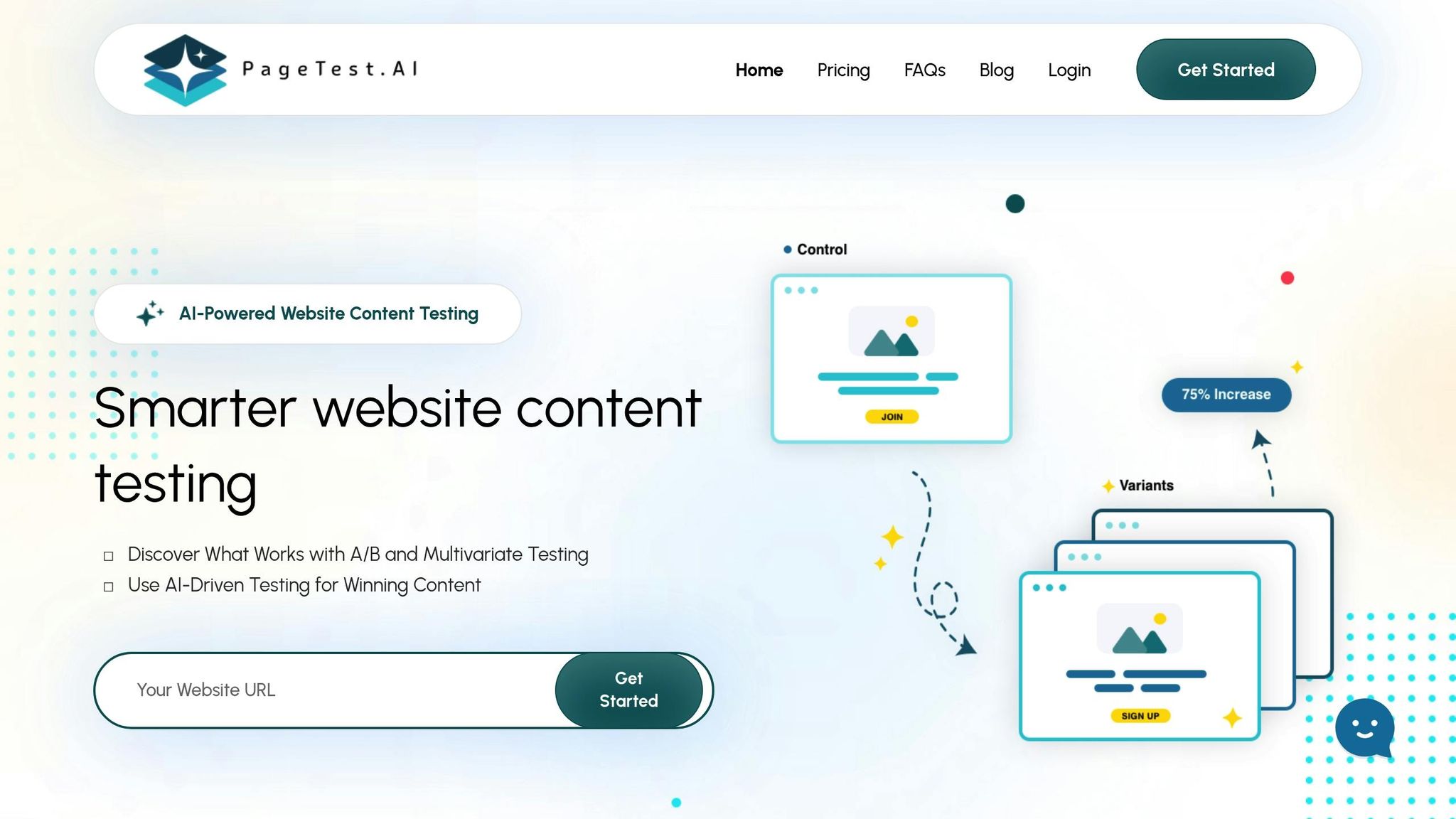

How AI Adapts Content for Multilingual Audiences

How AI Adapts Content for Multilingual Audiences
 29-07-2025 (Last modified: 07-08-2025)
29-07-2025 (Last modified: 07-08-2025)
AI is solving a big problem for businesses: creating content that works across multiple languages. Why does this matter? Because 75% of internet users search in languages other than English, and 40% of consumers won’t buy from websites that don’t support their native language. AI tools are making translations faster, cheaper, and more accurate while helping businesses connect with global audiences.
Here’s how AI is changing the game:
- Translation Gets Smarter: Tools like Neural Machine Translation (NMT) handle entire sentences, improving natural flow and reducing editing time by 25%.
- Content Creation Goes Local: Generative AI crafts text that matches local expressions, idioms, and preferences.
- Personalization at Scale: AI adjusts visuals, pricing, and even tone to match regional tastes.
- Cost and Time Savings: Companies report up to a 60% faster turnaround and 40–50% lower costs for multilingual content.
How to Use AI for Translation
AI Technologies for Multilingual Content
AI is transforming how businesses create content for global audiences, offering tools that make localization more accurate, engaging, and culturally relevant. Three key technologies – Neural Machine Translation (NMT), generative AI, and region-specific personalization – are at the forefront of this shift.
Neural Machine Translation (NMT)
Neural Machine Translation leverages deep learning to handle entire sentences, using an encoder-decoder model trained on massive datasets. This approach captures complex language nuances, producing natural-sounding translations instead of stiff, word-for-word conversions. By reducing post-editing time by up to 25%, NMT allows for faster localization and can be fine-tuned for specific needs, such as distinguishing between US and UK English or adapting to specialized fields like medicine, finance, or science.
Take Google Translate, for instance – it processes over 140 billion words daily using NMT. This efficiency lets human translators focus on polishing content rather than starting from scratch.
Philipp Koehn, a leading voice in AI translation, summarized the potential of NMT by saying:
"NMT is yet another step up and a very promising technology… NMT might be right for some applications today, it is important to understand the different technologies and their respective advantages and disadvantages…"
Building on NMT’s capabilities, generative AI takes things further by creating original content tailored to different cultural contexts.
Generative AI and Language Models
Generative AI models go beyond translation by creating culturally nuanced content. These systems analyze vast datasets to generate fresh material that respects idioms, metaphors, and local contexts. This makes it possible to craft marketing campaigns, slogans, and website content that stay true to the original message while adapting to specific cultural norms.
For example, the growing role of generative AI is evident in its market projections: the global AI market is expected to hit $1.8 trillion by 2030, with the generative AI segment alone reaching $110.8 billion. Beyond business applications, generative AI has also made strides in supporting underrepresented languages. Te Hiku Media‘s automatic speech recognition model for Te Reo Māori, for instance, achieved an impressive 92% transcription accuracy.
Generative AI also excels at creating personalized content, such as custom learning materials or marketing campaigns that connect with specific audiences. However, for these tools to succeed, human oversight is crucial. Combining AI’s efficiency with human expertise ensures that cultural nuances and brand identity remain intact.
AI Detection and Personalization for Different Regions
Modern AI doesn’t just generate content – it tailors it to fit regional preferences and behaviors. By analyzing massive data sets, these systems identify cultural trends, regional humor, and user behaviors, enabling hyper-personalization at scale. Features like geolocation analysis and automatic language switching make it easier to adapt content for diverse audiences.
AI also adjusts visual elements, updates currency and pricing for local markets, and incorporates real-time factors like holidays, weather, and events to keep campaigns relevant. For example, Algolia streamlined its localization process by integrating AI-powered tools. What once required manual updates now takes just a quick review by human experts, speeding up content creation and improving user engagement.
Success in regional adaptation depends on diverse training data and human involvement. Businesses that include cultural experts in the review process are better equipped to meet the needs of different audiences. This approach is gaining traction – over half of companies now use AI tools for content creation, and 79% report improvements in quality as a result.
Together, NMT, generative AI, and advanced personalization tools ensure that content not only breaks language barriers but also connects meaningfully with audiences worldwide.
Best Practices for Multilingual Personalization
Creating effective multilingual content isn’t just about translating words. It takes a mix of AI-driven tools, human expertise, and constant performance monitoring to truly connect with diverse audiences.
Combining AI with Human Review
Did you know that 77% of consumers choose, recommend, or pay more for brands offering personalized experiences? This stat underscores why getting personalization right is so important – and why relying solely on AI isn’t enough. Human oversight is key to avoiding costly mistakes that could harm your brand’s reputation.
To strike the right balance, set up workflows where AI handles tasks at scale, like translating large volumes of text, while humans ensure the content feels authentic. Use tools like brand glossaries, style guides, and domain-specific terminology to maintain consistency. Then, have human linguists refine the AI’s output to ensure it reflects the right cultural nuances and intended meaning.
Take L’Oréal, for example. They train their AI systems to recognize the unique visual identity of their 37 brands. But they don’t stop there – human experts review the AI’s work to ensure it aligns with local expectations. As their team puts it:
"By using AI to scale creativity without losing authenticity, L’Oréal ensures its marketing feels genuinely localized, not just translated."
To ensure quality, have native speakers review the content and set up feedback loops so the AI can learn and improve its understanding of cultural subtleties. This approach helps move beyond basic translation to true localization.
Localizing Beyond Language
Localization isn’t just about translating words. AI can adapt content to meet regional standards, including currency symbols, date formats, and even design elements. For U.S. audiences, for instance, this means using dollars ($), MM/DD/YYYY date formats, imperial measurements like feet and pounds, and American spelling conventions (e.g., "color" instead of "colour").
AI also analyzes regional trends to pick up on local slang, industry terms, and cultural aesthetics. It can even tweak product descriptions to highlight features that matter most to specific regions. For example, what resonates with buyers in New York might differ from what appeals to shoppers in Tokyo.
Netflix is a masterclass in this kind of localization. Their AI adapts everything from thumbnails to titles and synopses to suit different audiences. It even makes predictive recommendations based on regional viewing habits. By tailoring cover images and descriptions to align with local preferences, Netflix avoids awkward translations and delivers a seamless user experience.
And here’s why it matters: Companies using personalization technology sell 30% more than their competitors. This kind of performance boost comes from addressing regional preferences that go far beyond just language. Whether it’s emphasizing specific product features or adjusting marketing messages to reflect American values, personalization pays off.
AI also helps flag potential cultural missteps by highlighting problematic text segments before content goes live. This proactive approach ensures your messaging resonates without causing unintended offense.
Tracking Performance and Making Improvements
Once your localized content is live, tracking its impact is essential. Keep an eye on metrics like engagement rates, conversion rates, time spent on page, and customer satisfaction scores across different language versions.
Here’s why it’s worth the effort: Emails with personalized subject lines are 26% more likely to be opened, and segmented campaigns see a 760% boost in email revenue. Additionally, 60% of businesses report higher conversion rates and better customer retention through personalized content. These numbers highlight the power of personalization and the need for ongoing testing and refinement.
Set up measurement frameworks to track performance across different markets. Use A/B testing to compare variations of AI-generated content and see what resonates best with each audience.
Zendesk provides a great example of this in action. They use AI to translate customer support tickets, help center articles, and live chats instantly. But they don’t stop there – they analyze global support trends to refine their responses and track customer satisfaction scores to measure success. This continuous feedback loop helps them improve service across regions.
To make your personalization efforts even stronger, use performance data to train your AI systems. For instance, if a particular phrase or approach works well in one market, feed that insight back into the AI. Over time, this process ensures your multilingual content becomes more effective, as real-world data drives improvements.
And here’s the bottom line: 80% of customers are more likely to buy from brands that deliver a personalized experience. Meeting this expectation isn’t about guessing what your audience wants – it’s about using real performance data to refine and optimize your content continuously.
sbb-itb-6e49fcd
AI Workflows for Multilingual Content Optimization
Expanding on earlier discussions about AI’s role in adapting content across cultures, a structured workflow is key to maintaining quality and consistency in multilingual projects. Optimizing multilingual content effectively requires a thoughtful mix of AI-driven automation and human expertise.
Content Generation and Human Review
The process starts with a thorough audit and classification of content to pinpoint localization challenges. Content should be grouped by purpose – whether it’s marketing material, product descriptions, or technical documents – and prioritized based on the level of cultural sensitivity required.
Once content is categorized, establish translation workflows that combine the speed of AI with the precision of human oversight. AI handles the initial translation, while human reviewers focus on ensuring the content aligns with cultural nuances. This hybrid method not only speeds up the process – cutting turnaround times by 60% – but also reduces costs by about 80%.
Take EduSphere as an example. This global online learning platform implemented an AI-enhanced transcreation system for educational campaigns in regions like Kenya, Indonesia, and Brazil. Their approach included fine-tuning language models, using prompt engineering for cultural adjustments, and involving native-speaking human reviewers. The results? A 50% faster time-to-market for localized campaigns, a 35% boost in click-through rates for Facebook and Google ads, and a 25% drop in localization costs.
To maintain efficiency and accuracy, clear post-editing guidelines are essential. Human editors focus on areas where AI typically falls short – like cultural context, brand voice, and regional preferences – leaving repetitive tasks such as formatting and basic grammar fixes to AI.
Once the content is polished and approved, the next step is deployment and real-time testing.
Deployment and A/B Testing
With the content finalized, the real challenge begins: optimizing its performance. Deploying localized content involves ongoing testing to see what resonates best with different audiences. Instead of assuming a direct translation will suffice, test variations of headlines, calls-to-action, and user interface elements across languages. Platforms like PageTest.AI are particularly effective for this type of multilingual optimization.
"By combining AI-driven translation workflows with built-in A/B testing tools, it introduces a scalable solution that turns localization into an experiment-ready, data-informed process. This approach transforms localization into a data-driven process." – MultiLingual Staff
During deployment, integrate AI into your content management or e-commerce platform. Configure language settings so the right content is automatically displayed to users based on their location, browser preferences, or other factors. Automation ensures updates to the original content flow seamlessly across all localized versions.
For businesses using PageTest.AI, this process is straightforward. The platform integrates with popular tools like WordPress, Wix, and Shopify, enabling businesses to test content across multiple languages without technical hurdles. For instance, you can experiment with whether U.S. audiences prefer direct, benefit-focused headlines or messaging that emphasizes relationships and trust.
After deployment, a feedback loop ensures the workflow adapts to changing market demands.
Continuous Feedback and Refinement
The backbone of any successful AI workflow is a robust feedback system that enables continuous improvement. According to Gartner, generative AI is expected to account for 10% of all data produced by 2025, up from less than 1% today. This surge in AI-generated content makes it critical to have systems that learn and evolve.
Human reviewers play a key role in refining AI models. Their edits to AI-generated translations serve as valuable training data, helping the system improve with each iteration. This refinement process also involves analyzing performance across different markets and feeding those insights back into the content strategy. For example, if certain phrases or approaches consistently perform well in specific regions, they can inform future AI prompts and editing guidelines. Conversely, if certain content struggles in specific markets, the workflow can be adjusted to include more human oversight.
Maintaining consistency in terminology and brand voice is particularly important at this stage. AI systems need clear instructions on how your brand should sound across different languages and cultures, and human reviewers ensure these standards are upheld.
Regular audits are essential to keeping the workflow effective as content demands grow and markets evolve. This involves reviewing AI performance metrics, analyzing feedback from human editors, and adjusting processes based on market trends. Companies that treat their multilingual AI workflows as dynamic systems – adapting to business needs and market feedback – can turn localization into a strategic advantage.
Choosing AI Content Adaptation Solutions
Once your multilingual content workflows are in place, the next step is selecting the right AI platform to power your global content strategy. The challenge? Not all platforms are designed to handle cross-cultural adaptation or performance tracking effectively. Choosing the right tool requires careful consideration of your established workflows and ongoing optimization goals.
Key Features to Look For
When evaluating AI content adaptation platforms, language coverage should be a top priority. While some platforms boast support for over 100 languages, the real question is whether they can handle the specific languages your business requires. Beyond simple translation, look for platforms offering AI-assisted translation paired with integrated localization capabilities.
Another must-have is automated content synchronization and version control, which ensures your content remains consistent and accurate across all language variations. This feature is especially important for businesses managing frequent updates across multiple markets.
Effective collaboration is also key. Platforms offering customizable workflows for content creation, review, and approval make it easier for distributed teams – spread across time zones and cultural contexts – to work together seamlessly.
To measure success, look for tools with real-time analytics and reporting. These features help track how content performs in different markets, giving you the insights needed to make informed decisions. Research shows that localized user experiences can boost sales by 100–400%, underscoring the importance of detailed performance tracking.
Scalability is another critical factor. The platform should grow with your business, managing higher content volumes without compromising quality or speed. It should also integrate easily with your existing systems – like CRM, ticketing, or chat tools – to maintain a unified customer experience.
Finally, consider the cost and ROI. AI-powered content management solutions often lead to a 20–30% reduction in content creation and management costs, making them a smart investment for businesses looking to streamline operations.
PageTest.AI: A No-Code Optimization Solution

One standout tool in this space is PageTest.AI, which brings a fresh approach to multilingual content optimization. As an AI-powered conversion rate optimization platform, it simplifies A/B and multivariate testing for website content across different languages and markets.
What sets PageTest.AI apart is its no-code setup, making it accessible to marketing teams without technical expertise. Using a Chrome extension, users can select any website element – like headlines, CTAs, button text, or product descriptions – and generate AI-powered variations for testing. This is especially valuable for multilingual optimization, where success depends on more than just translation; it’s about crafting culturally relevant messaging.
For instance, while U.S. audiences might respond well to direct, benefit-driven headlines, European markets often prefer messaging that emphasizes relationships. PageTest.AI creates variations tailored to these preferences, ensuring your content resonates with diverse audiences.
The platform also tracks comprehensive performance metrics – such as clicks, engagement, time on page, and scroll depth – helping businesses fine-tune their content for different cultural contexts. With 67% of consumers preferring navigation and content in their language, this kind of tailored optimization is more important than ever.
PageTest.AI integrates with popular website platforms like WordPress, Wix, and Shopify, making it easy to implement multilingual testing without overhauling your existing infrastructure. Its flexible pricing starts with a free trial (10,000 test impressions) and scales to agency plans supporting up to 1 million impressions per month, catering to businesses at various stages of growth.
Comparison Table of AI Adaptation Features
| Feature Category | Key Advantages | Common Limitations | Best Use Cases |
|---|---|---|---|
| AI-Assisted Translation | Simplifies content management | May overlook cultural nuances without oversight | High-volume content with standardized messaging |
| Automated Synchronization | Maintains consistency across languages | Requires initial setup and configuration | Multi-market campaigns with frequent updates |
| Customizable Workflows | Enhances team collaboration | Can become complex with too many approval stages | Teams with strict quality control requirements |
| Real-Time Analytics | Enables data-driven decisions | Requires expertise to interpret cross-market data | Businesses focused on performance optimization |
| Scalability Features | Supports growing content needs | Costs can rise with higher volumes | Expanding businesses entering new markets |
The right AI adaptation platform depends on your unique business needs, technical capabilities, and growth goals. For businesses prioritizing conversion optimization and performance testing, tools like PageTest.AI are a great choice. On the other hand, companies with extensive translation needs may benefit more from platforms that specialize in language management systems.
As Naresh Prajapati from Azilen Technologies puts it:
"AI isn’t just about saving money – it’s about building a smarter, more agile business. True ROI comes from tracking both financial and strategic gains".
Conclusion and Key Takeaways
Why AI Matters for Multilingual Content
AI is changing the game for multilingual content by delivering personalized and culturally aligned experiences to audiences worldwide. Businesses that embrace these technologies are seeing measurable improvements in both customer satisfaction and engagement.
Take Vodafone, for example. Their AI-powered multilingual voicebot slashed customer service costs by 30% while boosting customer satisfaction by 40%. That’s a real-world example of how AI can thrive in diverse markets. And here’s another key fact: 42% of consumers steer clear of buying products or services if they’re not presented in a language they fully understand. By using AI to communicate in native languages, businesses can break through barriers that have historically hindered global growth.
What makes AI even more powerful is its ability to learn and improve. Through real customer interactions, it adapts to accents and industry-specific terms, ensuring that multilingual content becomes even more effective over time.
"As AI systems grow more advanced and integrate further into business operations, their benefits only multiply."
- Angel Vossough, co-founder and CEO of BetterAI
AI also offers scalable, round-the-clock support across multiple languages, maintaining consistent quality without the logistical headaches of traditional multilingual management. These capabilities set the stage for businesses to harness AI and reshape their content strategies.
Next Steps for Businesses
So, how can businesses take advantage of these AI-driven benefits? Start by identifying the types of content that will benefit most from automation – think product descriptions, FAQs, and customer support materials.
From there, focus on testing and refining your approach. Tools like PageTest.AI allow you to easily create and test culturally tailored content variations without requiring technical know-how. By tracking performance metrics like clicks, engagement, and time spent on a page, you’ll gain a clear understanding of what works best for your audience.
The cost savings are undeniable. Consider Coursera: AI has reduced the cost of translating a course from $13,000 to just $20.
"Thanks to AI, translating a course now costs us $20, compared to $13,000 previously."
- Jeff Maggioncalda, CEO at Coursera
But don’t rely on AI alone. Pair its efficiency with human expertise. Use AI for the heavy lifting – initial content creation and adaptation – and let human reviewers refine the output to ensure it captures cultural nuances and aligns with your brand voice. Keep in mind that translating content into as few as 10 languages can help you reach 90% of online users, and over 55% of global consumers prefer to shop on websites in their native language. By combining AI automation with strategic human input, businesses can open the door to global markets and deliver experiences that feel personal and authentic.
FAQs
How does AI handle cultural nuances to ensure accurate translations?
AI uses sophisticated algorithms to interpret cultural markers, idiomatic phrases, and context, enabling translations that connect with various audiences. By adapting content to align with local customs and preferences, it ensures the message comes across as natural and relatable.
That said, while AI excels at processing large volumes of data to spot patterns, it often takes human insight to catch the finer cultural details and guarantee the translation truly matches the audience’s expectations. The ideal approach blends AI’s speed and accuracy with human expertise to deliver high-quality, culturally attuned multilingual content.
How do human reviewers improve AI-generated multilingual content?
Human reviewers are essential in perfecting AI-generated multilingual content. They ensure translations are accurate, align with cultural norms, and connect with the intended audience. By catching subtleties or mistakes that AI might overlook, they uphold quality standards and improve the content’s overall impact.
Their expertise is particularly valuable when dealing with cultural nuances, idiomatic phrases, and intricate language patterns, helping to create content that feels more genuine and engaging for a variety of audiences.
How can businesses evaluate the success of AI-powered multilingual content strategies?
Businesses can measure the effectiveness of their AI-powered multilingual content strategies by keeping an eye on specific performance metrics tied to their objectives. Metrics like search rankings for localized keywords, user engagement (e.g., time spent on a page or bounce rates), and conversion rates in targeted regions can reveal how well the strategy is working.
On top of that, tracking customer satisfaction scores and collecting feedback from various audience groups can offer deeper insights. Reviewing these data points helps businesses adjust their approach to build stronger connections with multilingual and diverse audiences.
Related posts
say hello to easy Content Testing
try PageTest.AI tool for free
Start making the most of your websites traffic and optimize your content and CTAs.
Related Posts

 01-01-2026
01-01-2026
 Ian Naylor
Ian Naylor
Core Web Vitals vs. Page Speed: Key Differences
Compare Core Web Vitals (LCP, INP, CLS) with Page Speed metrics like FCP and TTI — learn their SEO roles, measurement differences, and optimization tips.

 30-12-2025
30-12-2025
 Ian Naylor
Ian Naylor
User Engagement Score Estimator
Estimate your website’s user engagement score with our free tool! See how interactive your content is and get tips to improve user interest.

 29-12-2025
29-12-2025
 Ian Naylor
Ian Naylor
CTA Phrase Planner
Struggling with CTAs? Use our free CTA Phrase Planner to create powerful, tailored call-to-action phrases that convert your audience!
